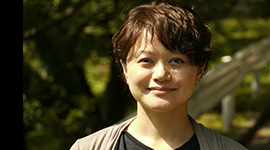I Want to Learn How to Think Beyond Academic Disciplines
Vol.4 2015.03.16 YOTSUMOTO Yuko
The Brain, the Mind and the Mirror
2015/3/16-3/17
The theme of this lecture is ‘The Brain, the Mind and the Mirror’. Therefore, I am going to refer to the information of cognitive brain science and psychology regarding the mirror. I will give an outline of ‘mirror self-recognition’, ‘mirror drawing’, ‘mirror therapy’ and ‘mirror neuron’ and will introduce the experimental method which verifies their mechanisms. Firstly, I am going to discuss the reason why we are able to recognize ourselves in the mirror as our self as well as verifying whether animals are able to recognize themselves in the mirror as them self. Although the image, which is reflected in the mirror, is reversed right and left, why the top and bottom is not reversed (‘mirror self-recognition’)? Secondly, we will learn the role of the right and the left cerebral hemispheres and examine the nature of communication between the right brain and the left brain through demonstration experiments called mirror drawing (‘mirror drawing’). Thirdly, we are going to learn the mechanism of the sensory area and the motor area in the cerebral cortex and will comprehend the contrivance of ‘mirror therapy’. Utilizing the mutual function of information processing and visual sensation, mirror therapy makes people, who lost the functions of sense and motion owing to a cerebral infarction or a brain haemorrhage, recover (‘mirror therapy’). Finally, I will explain the mechanism of the mirror neuron and its achievement, which is regarded as one of the greatest scientific discoveries in the 20th century (‘mirror neuron’). The purpose of this lecture is to understand the mechanism of human cognition through the theory and experimentation regarding the mirror in cognitive neuroscience and psychology. (We are going to conduct an experiment on the measurement time for ‘mirror drawing’. Bring your stop-watch or a watch which has a second hand if you have it.)
- Instructor
-

- YOTSUMOTO Yuko
- Associate Professor at the Department of Life Sciences, Graduate School of Arts and Sciences, the University of Tokyo She obtained her PhD in psychology at Brandeis University. Focussed on cognitive neuroscience, she has studied the process in which various information is conducted and combined in the brain and becomes ‘perception and consciousness’, through behavioural experimentation and measurement of brain activity.
comments(最新2件 / 6)
 2015年03月30日 15:49
reply
2015年03月30日 15:49
reply
【学生からの質問】
海馬を失った人が、すごく刺激的なことを経験して、強い感情を持ったとします。しかし、その後、記憶は失われて、その強い感情や感覚といったものも残らないのですか? 脳が忘れたとしても、心が何かを覚えていますか?
 2015年03月30日 15:49
reply
2015年03月30日 15:49
reply
【学生からの質問】
機能局在では、機能にあわせてニューロンが異なるのか、全く同じニューロンで機能を分けているのか知りたい。
 2015年04月03日 11:34
reply
2015年04月03日 11:34
reply
【四本先生からの回答】
好きや嫌いといった情動は、脳の本能的な働きが関わっています。好きという情動は、良いものには近づくという行動を、嫌いという情動は、嫌なものは避けるという行動を誘発することによって、より生存できるように進化してきたのです。脳の部位としては、「頭の良い」処理をしているとされる、脳の一番外側(大脳新皮質)ではなく、より内側にある神経細胞の集団が関わっているとされます。嫌いという情動が引き起こされるときには、扁桃体という箇所が活動することが知られています。
 2015年04月03日 11:35
reply
2015年04月03日 11:35
reply
【四本先生からの回答】
海馬を損傷している患者さんでは、短期記憶を長期記憶には変換できません。そのため、意識的な経験として記憶に残すことができなくなってしまいます。しかし、強い感情を伴う経験、例えば電気ショックを受けたという過去が、無意識的に未来の行動に影響を与えることはあります。ある実験では、過去にある状況下で電気ショックに受けたことがある海馬損傷患者は、次に同じ状況に置かれた際に、「自分は過去に電気ショックを受けた」ということを思い出すことはできないのですが、生理指標を計測すると、初めてその文脈にさらされた時と異なる反応を示しました。この患者の意識的は記憶していませんでしたが、無意識が文脈を覚えていたと考えられます。
 2015年04月03日 11:36
reply
2015年04月03日 11:36
reply
ニューロンの基本的な働きは脳のどの箇所でも同じです。どのニューロンも、一つまたは複数の神経細胞から入力を受けとり、その情報を統合した結果を一つまたは複数の神経細胞に出力します。入力の種類や情報の統合方法、出力先は個々のニューロンによって異なり、こうしたニューロンが組み合わさることによって脳の機能は生み出されます。
Post a Comment
- Other Lessons
【学生からの質問】
好きな感じとか、悪い感じが頭の中に浮かぶのは、脳のどのような機能によるものですか。また、好きな感じが悪い感じに(または悪い感じが好きな感じに)転移するときに、頭の中では具体的にどのような表現がなされているのでしょうか。